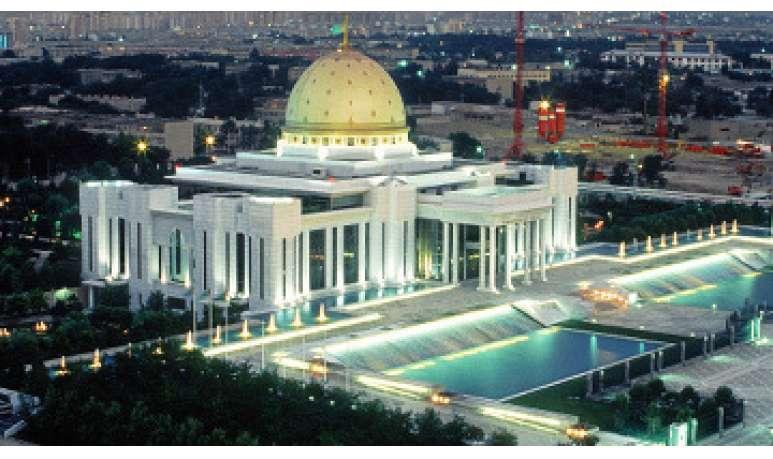Turkmenistan

General information. Turkmenistan is located in Central Asia. It shares borders with Kazakhstan, Uzbekistan, Afghanistan and Iran, on the west surrounded by the Caspian Sea. Area – 488 thousand square kilometers.
Population - about 7 million people.
Capital - Ashgabat (about 950 thousand people). Other major cities of Mary, Turkmenabat, Balkanabat, Turkmenbashi, Dashoguz.
Official language is Turkmen.
Currency – Turkmen new manat (1 U.S. dollar equals to 2.85 manat).
National day is the Independence Day on October 27.
April 8, 1992 were established diplomatic relations with the Russian Federation.
History. From 60-ies of XIX century begins the process of joining the territory of Turkmenistan to Russia. In tote, it lasted from 1865 to 1896. In 1918 was formed the Turkestan Autonomous Soviet Socialist Republic within the Russian Soviet Federative Socialist Republic. In 1924, it was transformed into Turkmen SSR. October 27, 1991 was proclaimed the independent statehood of Turkmenistan.
Polity. According to the Constitution (approved May 18, 1992, new editions adopted in August 2003 and September 2008), Turkmenistan is a democratic, legal, secular state with a presidential form of government.
President (elected February 11, 2007 for a period of five years), Gurbanguly Berdimuhamedow is head of state and chairman of the Cabinet of Ministers, the supreme commander in chief of the Armed Forces; he is the guarantor of national independence, territorial integrity, respect for the Constitution and international agreements. President issues decrees, decisions and orders that are binding on the entire territory of the country, sign or reject laws passed by Parliament, appoint and dismiss members of the management within the Government, manages the implementation of foreign policy, considers applications for citizenship of Turkmenistan, provides asylums, and solves a number of other issues referred to him by the Constitution.
Legislature is Majlis (Parliament). The last parliamentary elections were held on 14 December 2008. In accordance with the new Constitution edition, the power of Parliament is significantly expanded and the number of deputies increased from 50 to 125.
The jurisdiction of the Parliament include: the adoption of laws, corrective actions and additions to the Constitution and laws, ratify and denounce of international treaties; election of the Majlis chairman, his deputy, their dismissal; education, reorganization and abolition of committees and commissions, election and dismissal of their chairmen and others. Work order of Majlis and its structures are defined by regulations of Parliament.
Current parliament consists of five committees: protection the rights and freedom of people; science; education and culture; economy and social policy; international and inter-parliamentary relations; work with local authorities and self-government.
The Cabinet of Ministers is the operating agency and regulatory authority. It is formed by the President and abdicates responsibility to the newly elected president. Cabinet of Ministers ensures the implementation of laws, acts of the President; develops and implements programs of economic and social development of the country; takes steps to strengthen the monetary and credit system; implements foreign policy; ensures the development of cultural relations with foreign countries; is responsible for the preservation of peace and national security. Several chairman’s deputies also head ministries.
Political division and local authority
Turkmenistan is made up of five regions: Ahal (Anau), Balkan (Balkanabat), Lebap (Turkmenabat), Mary (Mary), Dashoguz (Dashoguz).
Each region, in turn, is divided into districts. Ashgabat equated by status to the region and divided into districts: Kopetdag, Azatlyk and Niyazov. Executive power is carried out by heads of administration in regions and cities. Heads of administration represent the President and are appointed and dismissed by the President.
Economy
Minerals. According to experts, the gas reserves make up 24.6 trillion cubic meters, oil - 21 billion tons. There are large deposits of sulfur, potash and rock salt, non-ferrous and rare-earth metals, etc.
In 2010 was produced 45 billion cubic meters of gas; oil - about 10 million tons and generated 16.8 billion kilowatt/hour of electricity.
Industry of Turkmenistan is represented by the following leading sectors: oil and gas, chemical, light, (including cotton-cleaning), food. The main products of the agricultural sector are cotton, fruit and vegetables, watermelons, melons and gourds.
In 2010, Turkmenistan's foreign trade turnover was equal to 17.883 billion U.S. dollars. Trade partners of Turkmenistan are 106 countries in the world.
Foreign policy. Turkmenistan has established and maintains relations with 129 states. In Ashgabat functions embassies and missions of 29 countries, and a number of international organizations. Turkmenistan is a member of a number of universal and regional organizations, including the UNO, OSCE, ECO, OIC. Besides, it joined NATO’s programme "Partnership for Peace".
In the capacity of basic principles of the foreign policy of Turkmenistan was declared permanent neutrality, which is fastened by the corresponding resolution of the 50th session of the UNO General Assembly (December 1995).
























